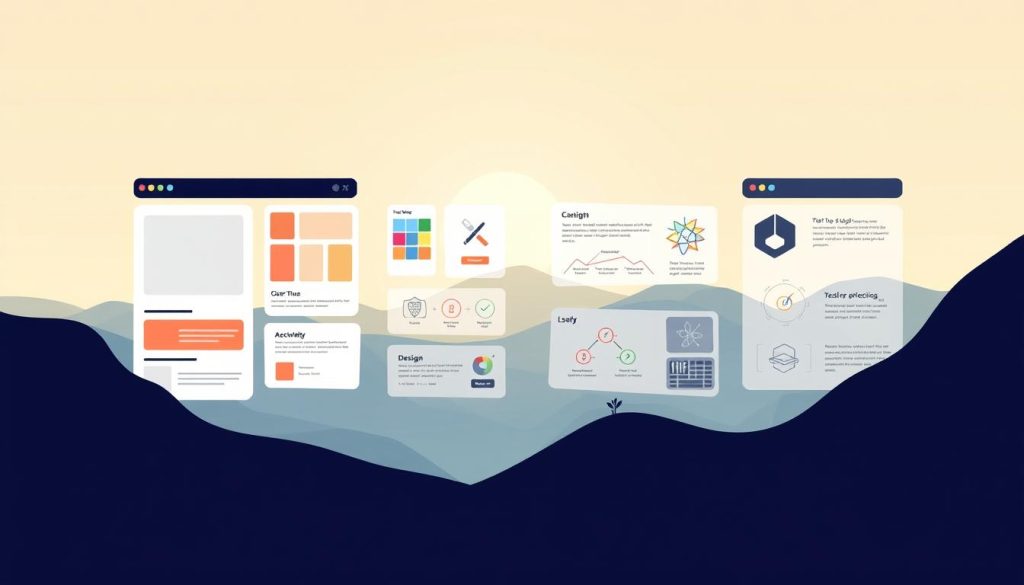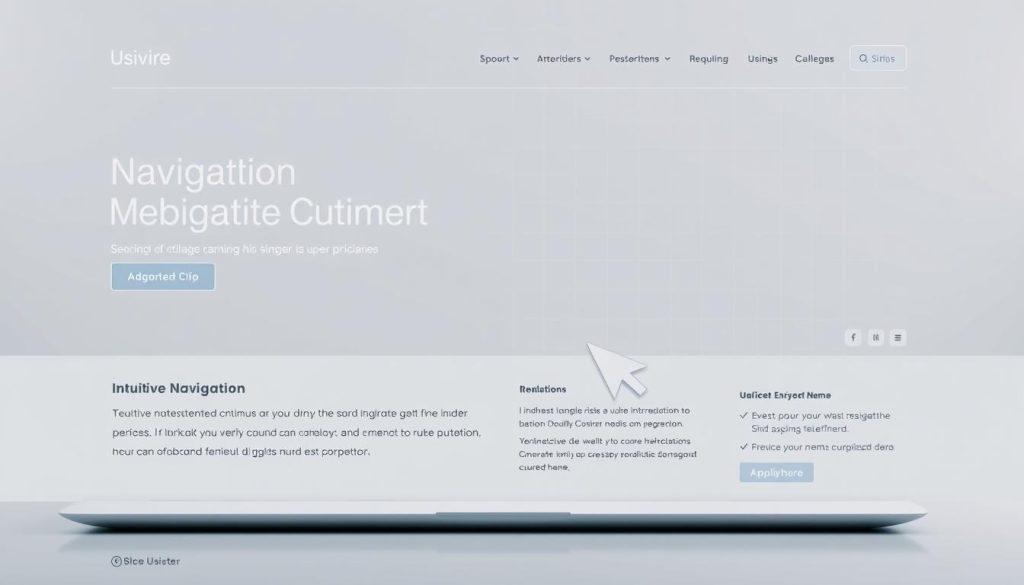Welcome to your essential guide for transforming your digital presence. Discover why the quality of interaction on your site is the secret weapon for boosting conversion rates and growing your business.
In today’s competitive online world, having a website is just the first step. You need to create meaningful journeys that guide visitors effortlessly toward taking action. This could be making a purchase, signing up for a newsletter, or engaging with your content.
This guide covers everything you need to know about improving site interactions. We’ll move from foundational ideas to advanced strategies used by leading companies. You will see how thoughtful design choices, based on research, can dramatically improve performance.
We will explore practical techniques and real-world examples. These are actionable strategies you can implement immediately to see improvements in your conversions and overall business metrics. A focus on improvement is key to staying ahead.
Whether you’re a business owner, marketer, or designer, this guide provides the knowledge to make informed decisions. Get ready to learn how small changes lead to significant improvements in how people interact with your brand.
Table of Contents
Key Takeaways
- A great site journey is a powerful tool for increasing sales.
- Simple navigation keeps visitors engaged and reduces the chance they will leave.
- Strategic design builds trust and encourages actions that benefit your business.
- Testing different site elements can reveal surprising ways to boost performance.
- Every second of load time matters for keeping potential customers.
- A positive interaction makes people more likely to return.
Introduction to User Experience: The Ultimate Guide
The concept of user experience has transformed how we approach digital product creation and customer satisfaction. It’s a field that touches every aspect of how people interact with technology.
Definition and Scope
User experience represents the complete journey someone has with any product or service. It goes far beyond just websites and apps.
This comprehensive approach considers both practical functionality and emotional response. Good UX balances ease of use with positive feelings.

The scope extends to physical products, services, and systems. Every interaction creates an experience that can be optimized.
A Brief History and Evolution
Donald Norman coined the term « user experience » in 1993 while at Apple. He’s widely recognized as the field’s founding father.
Norman later established the Nielsen Norman Group. This firm became a leading voice in UX research and consulting.
The discipline has grown from niche concern to business essential. Companies now recognize that great experiences drive loyalty and success.
Key Principles and Best Practices in UX Design
Great digital products don’t happen by accident—they’re built on solid design principles. These guidelines help create interfaces that people genuinely enjoy using.

Usability and Interaction Design
Usability ensures your product works well for real people. It’s about making tasks easy to complete. Good interaction design creates smooth flows between actions.
Think about how people navigate through your product. What actions do they want to take? Make these interactions effortless and intuitive.
Emotional Impact and Design Thinking
Beyond functionality, emotional connection matters. Design thinking helps solve problems with empathy. This approach puts you in your audience’s shoes.
Understanding their needs and frustrations leads to better solutions. The process is iterative, evolving through testing and feedback.
Balance visual appeal with genuine enjoyment. Create products that are both beautiful and satisfying to use.
Innovative Approaches to Optimize Website Usability
Navigating through a website should feel intuitive and effortless, guiding visitors toward their goals without confusion. Modern websites need innovative thinking to stand out. They must work beautifully for everyone who visits.
Great usability turns casual browsers into loyal customers. It removes frustration points that cause people to leave. Every element should serve a clear purpose.

Accessibility and Clear Navigation
Accessibility ensures your website works for people with different abilities. It’s both ethical and smart business. Everyone deserves equal access to information.
Clear navigation helps visitors find what they need quickly. A logical menu structure prevents confusion. People appreciate when they don’t have to search for basic information.
Implementing user-friendly navigation makes your site more welcoming. Visitors stay longer when movement feels natural. This approach builds trust in your brand.
Responsive Design for Multiple Devices
Responsive design adapts your content to any screen size. People access websites from phones, tablets, and computers. The experience must remain excellent across all platforms.
Mobile optimization is no longer optional. Most web traffic comes from smartphones. Pages must load quickly and display properly on smaller screens.
Testing on various devices ensures consistency. What works on desktop might fail on mobile. Regular checks prevent unpleasant surprises for visitors.
| Feature | Good Usability | Poor Usability | Impact |
|---|---|---|---|
| Page Load Time | Under 3 seconds | Over 5 seconds | High bounce rate |
| Navigation | Intuitive menu | Hidden links | Visitor confusion |
| Mobile Design | Responsive layout | Broken elements | Poor engagement |
| Accessibility | Screen reader friendly | No alt text | Limited audience |
Focusing on these areas creates a solid foundation. Visitors notice when a website works well. They’re more likely to return and recommend your site to others.
Proven Strategies for Boosting Conversions through Optimized Design
The bridge between casual browsing and committed purchasing is built through thoughtful interface design. When you focus on smooth customer journeys, you create opportunities for meaningful engagement.
Conversion Rate Optimization Techniques
Conversion rate optimization (CRO) systematically improves how visitors interact with your platform. This approach turns more visitors into paying customers.
Effective techniques include simplifying navigation and creating clear calls-to-action. Fast loading times also make a significant difference in completion rates.
A/B Testing and Iterative Improvements
A/B testing allows you to compare different versions of your design. This data-driven method reveals what truly works for your audience.
Usability testing provides valuable insights into customer behavior. Watching real people interact with your product shows where they struggle.
| Optimization Area | Before Improvement | After Improvement | Impact on Business |
|---|---|---|---|
| Checkout Process | 5-step, complex | 3-step, simplified | 15% higher completion |
| Call-to-Action | Subtle, blended | Contrasting, clear | 22% more clicks |
| Page Load Speed | 4.2 seconds | 1.8 seconds | 30% lower bounce |
| Mobile Navigation | Hidden menu | Visible, accessible | 18% more engagement |
This continuous improvement cycle keeps your conversion rates climbing. Every small change contributes to better customer satisfaction and business growth.
Leveraging User Research and Data-Driven Insights
Effective design decisions stem from a foundation of reliable data gathered directly from those who matter most. Moving beyond assumptions allows you to build products that truly resonate. This approach transforms guesswork into evidence-based strategy.

Gathering meaningful insights requires the right methods and tools. The combination of qualitative and quantitative approaches provides a complete picture.
Effective User Interviews and Surveys
Direct feedback through interviews and surveys offers invaluable perspectives. These methods help uncover pain points and preferences that might otherwise remain hidden.
Well-structured questions yield the most useful data. Satisfaction scores like NPS and CSAT provide measurable feedback. This research forms the basis for targeted improvements.
Behavioral Analytics and Usability Testing
Observing how people interact with your product reveals hidden patterns. Behavioral analytics tracks actions like click-through rates and navigation paths.
Usability testing shows real-time task completion and error rates. This testing identifies where people struggle without needing them to explain it.
Combining these methods creates powerful insights. The analysis informs design choices with concrete evidence rather than intuition.
Innovative Approaches to Enhance User Experience
Staying ahead in digital design requires embracing new methods and technologies. The field constantly evolves, demanding fresh strategies to create better products and services.
Modern tools and ongoing refinement processes are essential. They help teams work efficiently and keep offerings competitive.
Utilizing Modern UX Tools
Today’s design tools have transformed the creative process. Platforms like Figma and Sketch streamline prototyping and collaboration.
These solutions allow for rapid creation of interactive models. Teams can test ideas quickly and gather feedback from anywhere.
Analytics suites provide deep insights into how people interact with digital products. This data guides smarter design decisions.
Implementing Continuous Improvement Processes
Great design is not a one-time effort. It requires constant attention and adjustment.
Establish a regular schedule for collecting feedback and reviewing performance metrics. This practice helps identify areas needing enhancement.
After making changes, measure their impact. This cycle of testing and refinement ensures products evolve with audience needs.
| Tool Category | Example Tools | Primary Function | Impact on Workflow |
|---|---|---|---|
| Prototyping | Figma, Sketch | Interactive model creation | Faster iteration |
| Research | UserTesting, Hotjar | Behavioral analysis | Deeper insights |
| Analytics | Google Analytics, Mixpanel | Performance tracking | Data-driven decisions |
| Collaboration | Miro, InVision | Team communication | Improved coordination |
Combining the right tools with a commitment to ongoing improvement creates a powerful approach. This strategy keeps digital offerings fresh and effective.
Bridging the Gap: Transitioning from Graphic Design to UX Design
Many graphic designers are discovering exciting new career paths in the UX field. This shift represents more than just a job change—it’s an expansion of creative possibilities. The financial benefits are compelling, with PayScale data showing graphic designers earn around $41,000 annually while UX professionals command approximately $74,000.
Integrating Aesthetics with Functionality
Your graphic design background gives you a powerful advantage. You understand how visual elements create emotional connections. This skill becomes crucial when designing interfaces that balance beauty with practical utility.
The key is learning how aesthetics support functionality. Good visual design makes people more relaxed and creates positive first impressions. Your work should guide users intuitively through each interaction.
Career Shift Strategies and Skill Expansion
Transitioning successfully requires strategic skill development. Focus on learning user research methods like interviews and usability testing. These techniques help you understand audience needs beyond visual preferences.
Build a portfolio that showcases both your aesthetic skills and UX thinking. Consider courses from platforms like Interaction Design Foundation. Network with UX professionals to learn industry expectations.
This career move isn’t about abandoning your graphic design expertise. It’s about expanding your toolkit to create complete product experiences that people genuinely love using.
The Role of Emerging Technologies in Revolutionizing UX
The digital landscape is undergoing a remarkable transformation through cutting-edge innovations. These advancements are reshaping how people interact with digital products and services. Organizations now combine design thinking with agile development to create smarter solutions.
Frameworks like IBM Garage bring together technology experts, designers, and business stakeholders. This collaboration helps rapidly prototype innovative, customer-centered solutions. The focus shifts toward deeper personalization and more intuitive interactions.
Artificial Intelligence and Machine Learning
Artificial intelligence enables personalization at an unprecedented scale. Products can now adapt to individual preferences and predict needs before customers express them. Machine learning automates routine tasks, creating more efficient interactions.
These tools assist designers by generating data-driven personas and providing intelligent recommendations. They help create design variations for testing while complementing human creativity. The technology handles repetitive tasks, allowing designers to focus on strategic work.
Immersive Experiences with AR/VR
Augmented and virtual reality move beyond traditional screen-based interfaces. They create three-dimensional, spatial experiences that feel natural and engaging. These technologies find practical applications across multiple industries.
Retail experiences let customers virtually try products before purchasing. Training simulations provide safe, realistic practice environments. The growing field offers exciting opportunities for specialized developers to create these immersive worlds.
Other innovations like IoT and blockchain create connected ecosystems that work seamlessly together. They enable new models of trust and security that modern customers demand. The future promises increasingly intelligent interactions that anticipate needs and adapt to individual contexts.
FAQ
What is the difference between usability and user interface design?
Usability focuses on how easy and efficient a product is to use, while the user interface is the specific space where interactions between people and a system occur. Good design thinking ensures both work together for a smooth customer experience.
How can I identify pain points on my website?
You can uncover pain points through methods like usability testing, analyzing behavioral analytics, and conducting user research like surveys. Watching real people navigate your site often reveals where they struggle.
Why is responsive design so important for my site?
Responsive design ensures your content and navigation work well on any device, from desktops to phones. This improves satisfaction and supports your brand reputation by providing a consistent experience for all visitors.
What are some effective tools for conversion rate optimization?
Tools like Google Analytics for data insights and platforms for A/B testing are powerful. They help you test different page layouts and content to see what drives the best results for your business.
How does emotional impact play a part in design?
Emotional design aims to create positive feelings during interactions with a product. This can build a stronger connection to your brand and increase loyalty, making customers more likely to return.
What is the first step in transitioning from graphic design to UX design?
A great first step is to learn about user research and interaction design principles. Expand your skill set to include understanding customer needs and the entire process of how people use a product.





